

Perfect Bind-Off For Lace: The Frilled Standard Bind-Off. I’m so excited about bind-offs for lace right now.
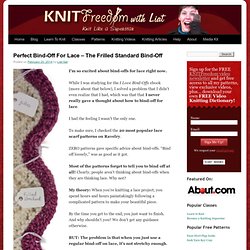
While I was studying for the I Love Bind-Offs ebook (more about that below), I solved a problem that I didn’t even realize that I had, which was that that I never really gave a thought about how to bind-off for lace. I had the feeling I wasn’t the only one. To make sure, I checked the 20 most popular lace scarf patterns on Ravelry. ZERO patterns gave specific advice about bind-offs. “Bind off loosely,” was as good as it got. Most of the patterns forget to tell you to bind off at all! My theory: When you’re knitting a lace project, you spend hours and hours painstakingly following a complicated pattern to make your beautiful piece.
By the time you get to the end, you just want to finish. BUT: The problem is that when you just use a regular bind-off on lace, it’s not stretchy enough. I know, stretchiness isn’t top-of-mind when you think about lace. And here’s where the bind-off is key because the bind-off has to be able to take all this abuse. Majoring in Lace - Part IV. Introduction; Shawl Construction • Yarn Choices; Needle Choices; Gauge: Chart Reading 101 • The Structure of Lace; Role of the YO; Role of the Decrease; Movements in Lace Knitting • Provisional and Invisible Cast Ons; Hard Cast Ons; Circular Beginnings Casting On For Lace One of the most curious things about lace is the goal of having no real beginning and no real end.
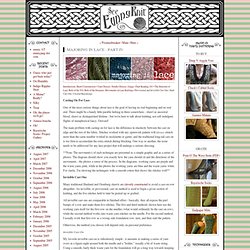
There might be a handy little parable lurking in there somewhere - shawl as ancestral blood, shawl as distinguished lifetime - but we're here to talk about knitting, not self-indulgent flights of metaphorical fancy. Onward! The main problem with casting on for lace is the difference in elasiticity between the cast on edge and the rest of the fabric. **Note: The movment(s) of each technique are presented as a simple graphic and as a series of photos. PDXKnitterati. Knitting. Knitting Histories A History of Hand Knitting Richard Rutt No Idle Hands: The Social History of American Knitting by Anne Macdonald Knitting by the Fireside and on the Hillside by Linda Fryer (Shetland Islands) The Loving Stitch: A History of Knitting and Spinning in New Zealand by Heather Nicholson 16th - 19th Century Bavarian/Austrian Peasant Knitting Oma's Strickgeheimnisse by Eichensee, Grill, and Krön Überlieferte Strickmuster Aus Dem Steirischen Ennstall (3 Volumes) by Maria Erlbacher Bauerliches Stricken (3 Volumes) by Lisl Fanderl Knitting Lace: A Workshop with Patterns and Projects by Susanna Lewis (Reproduction of a mid-19th century German lace sampler housed in the Brooklyn Museum ) The Knitted Lace Patterns of Christine DuchrowI (3 Volumes) : German Lace British Isles (Many of these books include historic photos and information on regional variations in patterns.The books on Guernseys (or Ganseys) contain regional variations unique to specific villages.

Eastern European. Sampler Afghan No. 3401, Volume 34. Printer-friendly version Send by email PDF version Approximate Size 60 x 76 inches Afghan illustrated is made of 2 shades of Gold and Black.
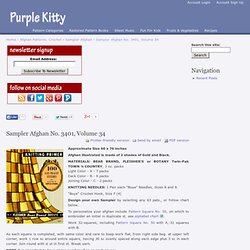
MATERIALS: BEAR BRAND, FLEISHER'S or BOTANY Twin-Pak TOWN 'n COUNTRY, 3 oz. packs Light Color - A - 7 packs Dark Color - B - 9 packs Joining Color - C - 2 packs KNITTING NEEDLES: 1 Pair each "Boye" Needles, Sizes 8 and 9. "Boye" Crochet Hook, Size F (4) Design your own Sampler by selecting any 63 pats., or follow chart below. To personalize your afghan include Pattern Square No. 50, on which to embroider an initial in duplicate st, see alphabet chart. Knitting conversions.
From The Knitting Fiend.
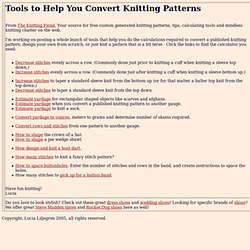
Your source for free custom generated knitting patterns, tips, calculating tools and mindless knitting chatter on the web. I'm working on posting a whole bunch of tools that help you do the calculations required to convert a published knitting pattern, design your own from scratch, or just knit a pattern that is a bit terse. Click the links to find the calculator you need: Expert Tips on Measuring Yourself for Knitting/Crocheting a Sweater. September 12th, 2013 by Guest Today, we have a guest post from Johnny Vasquez, a knitwear designer, and “Head Honcho” over at the New Stitch A Day blog.
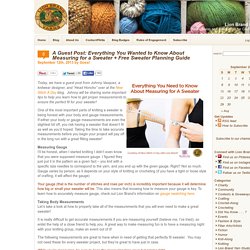
Johnny will be sharing some important tips to help you learn how to get proper measurements to ensure the perfect fit for your sweater! One of the most important parts of knitting a sweater is being honest with your body and gauge measurements. If either your body or gauge measurements are even the slightest bit off, you risk having a sweater that doesn’t fit as well as you’d hoped. Taking the time to take accurate measurements before you begin your project will pay off in the long run with a great fitting sweater! Measuring Gauge I’ll be honest, when I started knitting I didn’t even know that you were supposed measure gauge. Your gauge (that is the number of stitches and rows per inch) is incredibly important because it will determine how big or small your sweater will be. 1. 2. 3. 4. 5. 6. 7. 8. 9. 10. 11. 12.